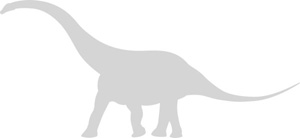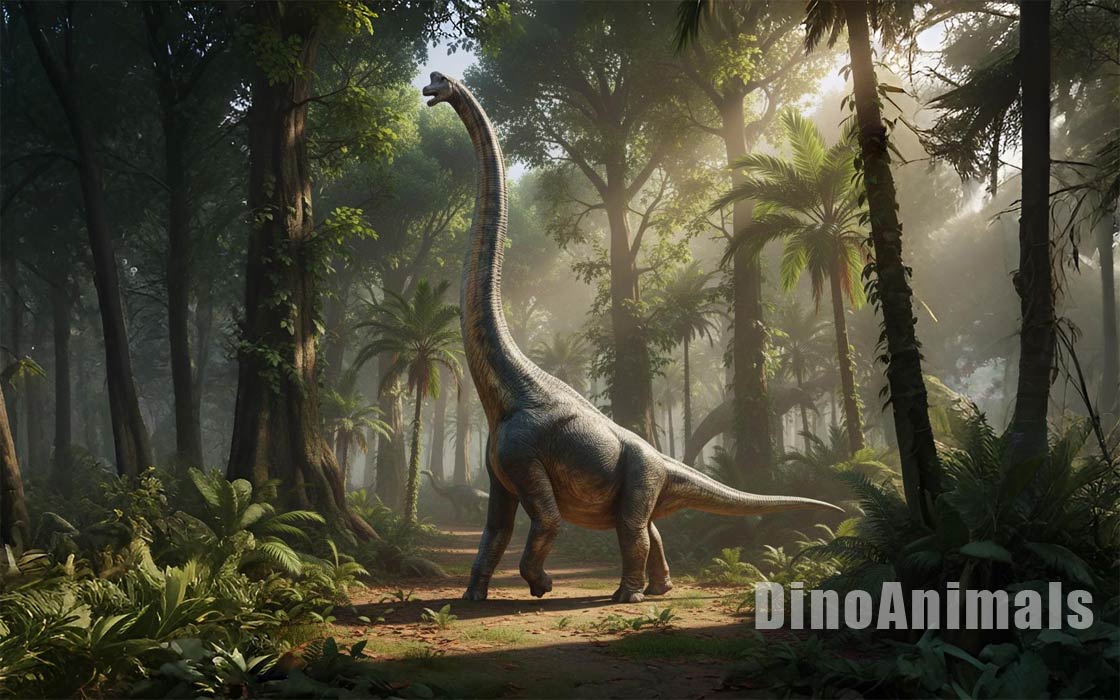Every month, 100,000 readers use the Dinosaur Database, but we receive no support from you. Developing and updating the database requires a lot of work. If you want it to remain open and be updated, please support us via the "Buy us a coffee" button available on every page or via the Support page.
Dinosaur: Brachiosaurus altithorax

| Length*: | 27 m | 88.6 ft |
| Weight*: | 57 t | 125,663 lb |
*The largest known specimen
Period
Epoch: Late Jurassic
Stage: Kimmeridgian-Tithonian
Years: 154-150 Ma
Details
Status: valid
Author: Riggs
Year: 1903
Distribution
Area: North America
Country: USA
Region: Colorado, Utah, Oklahoma, Wyoming
Formation: Morrison
Description
Brachiosaurus altithorax
Brachiosaurus altithorax is one of the most recognizable sauropod dinosaurs, known for its distinctive, upright posture and extremely long neck. This species lived during the Late Jurassic period, approximately 154–150 million years ago, in what is now North America. The name “Brachiosaurus” means “arm lizard,” referring to its disproportionately long forelimbs, while “altithorax” means “deep chest,” highlighting its unique body structure. Belonging to the Brachiosauridae family, Brachiosaurus has provided significant insights into the diversity and evolution of sauropod dinosaurs.
Physical Characteristics
Brachiosaurus altithorax was a massive quadrupedal herbivore, estimated to have reached lengths of up to 25 meters (82 feet) and weights around 30 to 50 metric tons. Unlike most other sauropods, Brachiosaurus had proportionally longer forelimbs than hind limbs, giving it an inclined body posture with a raised front and lower back. This unique body shape is believed to have allowed it to browse at heights that other sauropods could not reach, up to 9 meters (30 feet) above the ground. The neck was long and carried high, consisting of 12 to 14 elongated cervical vertebrae, and was held at a steep upward angle due to the elongated forelimbs. Its skull was relatively small compared to its body, with large nasal openings positioned above the eyes, suggesting that it had good olfactory capabilities. The teeth of Brachiosaurus were spoon-shaped (spatulate), which were well-suited for stripping leaves from trees. The robust body and deep chest cavity contained large lungs and a massive heart necessary for circulating blood to its elevated head. The vertebrae of Brachiosaurus were highly pneumatic (hollowed out with air sacs), reducing the overall weight of its long neck and body and aiding in respiration. Its limbs were thick and columnar, supporting its enormous weight, with the front limbs being notably longer, contributing to its unique upright posture.
Diet and Feeding Habits
Brachiosaurus altithorax was a high-browsing herbivore, feeding primarily on the leaves of tall trees, such as conifers, cycads, and ginkgoes. Its long neck allowed it to reach vegetation that was inaccessible to other herbivorous dinosaurs, giving it a significant feeding advantage. The spatulate teeth were adapted for stripping leaves rather than chewing; it is likely that Brachiosaurus swallowed its food whole, and the vegetation was broken down in its large gut through fermentation, similar to other large herbivores. The high position of its nasal openings and its upright posture suggest that it could have breathed easily while reaching high into trees for food. This dinosaur’s unique body shape and feeding strategy meant it could coexist with other large herbivores, such as Diplodocus and Apatosaurus, by exploiting a different ecological niche. The large size of Brachiosaurus also meant it had to consume vast amounts of plant material daily to sustain its energy needs, possibly requiring constant foraging throughout the day and night. Gastroliths, or stomach stones, may have been used to aid in the digestion of fibrous plant material.
Habitat and Distribution
Brachiosaurus altithorax fossils have been primarily found in the Morrison Formation of North America, a geologic formation that stretches across states such as Colorado, Wyoming, Utah, and Oklahoma. This formation represents a diverse ecosystem of the Late Jurassic period, characterized by semi-arid conditions with seasonal rainfall, floodplains, river valleys, and alluvial plains. The environment likely consisted of open woodland areas interspersed with conifer forests and fern prairies, providing ample food resources for large herbivores. The climate would have been warm, supporting a variety of plant life, including tall trees that were ideal for Brachiosaurus to browse. The widespread distribution of Brachiosaurus within the Morrison Formation indicates that it was well-adapted to a range of environments within this landscape, from wetter lowlands near rivers to drier upland regions. Its high-browsing habits would have allowed it to exploit a food source that was relatively abundant and less competed for by other herbivorous dinosaurs, further supporting its success in these varied habitats.
Behavior and Social Structure
Direct evidence of the behavior of Brachiosaurus altithorax is limited, but its anatomy and environment provide clues. It is believed that Brachiosaurus may have lived in herds or groups, which could provide protection against predators such as Allosaurus and Ceratosaurus. However, its massive size would have deterred all but the most determined predators, especially adult individuals. The unique body structure of Brachiosaurus suggests that it could feed on high vegetation that other herbivores could not reach, reducing competition for food resources. This adaptation may have allowed it to be more solitary or form smaller groups compared to other sauropods that grazed at lower levels. Its long neck and upright posture also suggest it may have used its height advantage for visual surveillance, spotting predators or other threats from a distance. The nasal openings located high on the skull may have allowed it to produce loud, resonant sounds for communication with other members of its species, especially over long distances. The large size of its lungs and heart would have facilitated such vocalizations. Additionally, evidence from closely related sauropods suggests that young Brachiosaurus may have grown rapidly to avoid predation, staying close to adults or forming “nursery” groups for protection.
Discovery and Research
Brachiosaurus altithorax was first described in 1903 by American paleontologist Elmer S. Riggs, based on fossils discovered in the Grand River Valley of western Colorado, USA. The initial discovery included a partial skeleton with well-preserved vertebrae, ribs, and limb bones, providing a clear picture of its unique body structure. The species name “altithorax” was given due to the unusually deep chest cavity of the dinosaur. Riggs’s discovery was significant because it highlighted the unique adaptations of Brachiosaurus, setting it apart from other known sauropods with its distinctive forelimb length and high-browsing feeding strategy. For many years, Brachiosaurus was considered the largest and tallest dinosaur known, a title it held until larger species like Argentinosaurus were described. Despite its fame, Brachiosaurus is primarily known from relatively fragmentary fossils, and much of what is understood about its anatomy has been inferred from related species such as Giraffatitan brancai, a close relative once classified as a species of Brachiosaurus. Recent studies have focused on differentiating Brachiosaurus from Giraffatitan and understanding the evolutionary relationships within Brachiosauridae. Ongoing research continues to refine our understanding of Brachiosaurus‘ anatomy, behavior, and ecological role.
Significance and Interesting Facts
Brachiosaurus altithorax is significant for its unique anatomical adaptations that allowed it to browse at heights unattainable by other herbivorous dinosaurs. Its upright posture and long neck have provided critical insights into sauropod diversity and evolutionary strategies. The discovery of Brachiosaurus also underscored the diversity of the Late Jurassic ecosystems, demonstrating how different species of large herbivores could coexist by occupying distinct ecological niches. Brachiosaurus has become a popular symbol of the giant dinosaurs due to its impressive size and unique body structure, featuring prominently in museums, films, and books. It has been central to debates on sauropod physiology, particularly how such massive animals were able to breathe, circulate blood, and maintain their large bodies. Although its fossils are relatively rare, Brachiosaurus remains one of the most iconic and well-known dinosaurs, representing the fascinating diversity of life that once roamed our planet.
Locations
Sources
Material: Partial skeleton, referred other specimens also skull material.
References: Taylor, M.P. (2009) "A re-evaluation of Brachiosaurus altithorax Riggs 1903 (Dinosauria, Sauropoda) and its generic separation from Giraffatitan brancai (Janensch 1914)".Mannion, P.D., Upchurch, P., Barnes, R.N. & Mateus, O. (2013) "Osteology of the Late Jurassic Portuguese sauropod dinosaur Lusotitan atalaiensis (Macronaria) and the evolutionary history of basal titanosauriforms".




